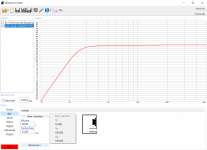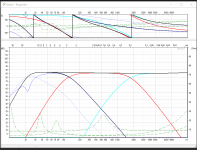Hello,
I'm planning to build my first pair of DIY speakers as an complement to my current Klein+Hummel O300D + 2x Adam Sub10 Mk2 setup. I mainly use them for mixing and post-production, but I'd like to do more mastering in the future and therefore I want a second (hopefully "better") set of speakers.
Since most mastering speakers are way out of my price range, I thought I try to build a good set of speakers myself. The last few months I gathered information about speakerbuilding and found many helpful posts on this forum, so I'd like to share my plans with you.
I'd be grateful if someone could point out some mistakes in my design or things that could be improved!
My design is mainly inspired by speakers like Egglestonworks - "Viginty" and "Kiva", Amphion - "Krypton³" and Lipinski "L-707".
I want to imply following features:
a) MTM/D'Appolito Satellite (maybe with a passive cardioid like the Krypton)
b) TL or vented Sub, high enough that I can put the satellit on it and have the
tweeter at about 115-122cm (my earlevel), but in a separate box to have
the freedom of experimenting with different room locations if the bass
response is not smooth enough at the triangle.
c) Drivers:
Mids: 6" Morel TSCM-634
Tweeter: Morel TSCT-1044 with Waveguide (Visaton WG148 or Monacor
WG-300, I'll have to test which fits better)
Bass: 10" Scan-Speak 26W/4867T00
d) Active analog 3-way Crossover: I have the Rane AC23S, which has fourth
order Linkwitz-Riley filters and a delay up to 2ms for the low and mid
channels.
e) Separate amp channels for woofer/mid/tweeters. At the moment I have 2
PAS 2002 PCA Stereo amplifiers. But I need at least 1 more (if not different, more powerful
amplifiers). This is one of the points where I am not sure about.
I'm planning to build my first pair of DIY speakers as an complement to my current Klein+Hummel O300D + 2x Adam Sub10 Mk2 setup. I mainly use them for mixing and post-production, but I'd like to do more mastering in the future and therefore I want a second (hopefully "better") set of speakers.
Since most mastering speakers are way out of my price range, I thought I try to build a good set of speakers myself. The last few months I gathered information about speakerbuilding and found many helpful posts on this forum, so I'd like to share my plans with you.
I'd be grateful if someone could point out some mistakes in my design or things that could be improved!
My design is mainly inspired by speakers like Egglestonworks - "Viginty" and "Kiva", Amphion - "Krypton³" and Lipinski "L-707".
I want to imply following features:
a) MTM/D'Appolito Satellite (maybe with a passive cardioid like the Krypton)
b) TL or vented Sub, high enough that I can put the satellit on it and have the
tweeter at about 115-122cm (my earlevel), but in a separate box to have
the freedom of experimenting with different room locations if the bass
response is not smooth enough at the triangle.
c) Drivers:
Mids: 6" Morel TSCM-634
Tweeter: Morel TSCT-1044 with Waveguide (Visaton WG148 or Monacor
WG-300, I'll have to test which fits better)
Bass: 10" Scan-Speak 26W/4867T00
d) Active analog 3-way Crossover: I have the Rane AC23S, which has fourth
order Linkwitz-Riley filters and a delay up to 2ms for the low and mid
channels.
e) Separate amp channels for woofer/mid/tweeters. At the moment I have 2
PAS 2002 PCA Stereo amplifiers. But I need at least 1 more (if not different, more powerful
amplifiers). This is one of the points where I am not sure about.
Last edited:
Satellite Box Construction
I want to make the cabinet out of two 18mm sheets MDF laminated together (maybe with Swedac Damping Glue DG A2, if I can get my hands around it)
The tapered enclosures are thought to be 10mm plywood or is this too thin?
And should I plan more bracing?
On the sides you can see a pattern of holes which will hopefully make a cardioid response. On pic 3 you can see two 3cm thick pieces of acoustic foam on the sidewalls. Together with the holes this should make a aperiodic enclosure.
The centers of the mid-drivers and the tweeter are located together as close as possible. For a "perfect" D'Apollito arrangement I'd need to cross them at 1655hz, which I think should be reachable with the use of the waveguide.
Here are some pics of my sketchup plans:
I want to make the cabinet out of two 18mm sheets MDF laminated together (maybe with Swedac Damping Glue DG A2, if I can get my hands around it)
The tapered enclosures are thought to be 10mm plywood or is this too thin?
And should I plan more bracing?
On the sides you can see a pattern of holes which will hopefully make a cardioid response. On pic 3 you can see two 3cm thick pieces of acoustic foam on the sidewalls. Together with the holes this should make a aperiodic enclosure.
The centers of the mid-drivers and the tweeter are located together as close as possible. For a "perfect" D'Apollito arrangement I'd need to cross them at 1655hz, which I think should be reachable with the use of the waveguide.
Here are some pics of my sketchup plans:
Attachments
-
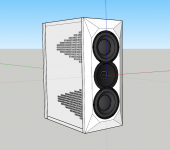 Screenshot 2019-04-16 13.57.11.png89.5 KB · Views: 814
Screenshot 2019-04-16 13.57.11.png89.5 KB · Views: 814 -
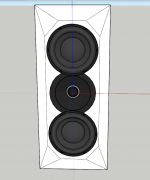 Screenshot 2019-04-16 13.58.08.png80.1 KB · Views: 439
Screenshot 2019-04-16 13.58.08.png80.1 KB · Views: 439 -
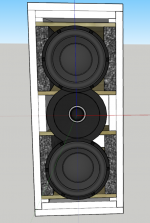 Screenshot 2019-04-16 13.59.08.png199.2 KB · Views: 583
Screenshot 2019-04-16 13.59.08.png199.2 KB · Views: 583 -
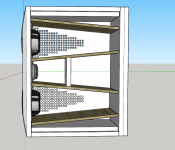 Screenshot 2019-04-16 14.00.04.png105.1 KB · Views: 433
Screenshot 2019-04-16 14.00.04.png105.1 KB · Views: 433 -
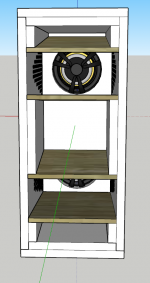 Screenshot 2019-04-16 14.01.03.png77.4 KB · Views: 440
Screenshot 2019-04-16 14.01.03.png77.4 KB · Views: 440 -
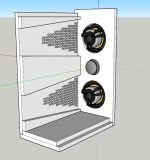 Screenshot 2019-04-16 14.01.12.png90.3 KB · Views: 179
Screenshot 2019-04-16 14.01.12.png90.3 KB · Views: 179
Last edited:
Some Calculations
Somewhere I've read that you can simulate an aperiodic enclosure in WinISD with a box leakage(Ql) of "3", is that correct? Furthermore I simulated some stuffing with the a Qa of "10". Which gives me a Qtc of 0,704 at 9L .
For the sub I simulated a big(99L) vented enclosure, because most programs I found can't simulate a transmission line and I'm not yet good enough in hornResp.
Then in Basta! I simulated a active crossover so see how the drivers fit together:
Somewhere I've read that you can simulate an aperiodic enclosure in WinISD with a box leakage(Ql) of "3", is that correct? Furthermore I simulated some stuffing with the a Qa of "10". Which gives me a Qtc of 0,704 at 9L .
For the sub I simulated a big(99L) vented enclosure, because most programs I found can't simulate a transmission line and I'm not yet good enough in hornResp.
Then in Basta! I simulated a active crossover so see how the drivers fit together:
Attachments
Off topic
Can you tell us your impression about the PAS 2002 PCA poweramp? Comparing it with others you've heard or had, please.
Can you tell us your impression about the PAS 2002 PCA poweramp? Comparing it with others you've heard or had, please.
Hello Patrick,
Did you get on with that project?
Around the same time, I had similar ideas. I started off with active crossovers on the back side, but went to passive later on.
The design is quite simple: Develop just the normal front side of the speaker, double the volume for the rear woofer and link it with a serial inductance and resistance to the lowpass of the front woofers.
Hifi-Zirkel.de • Thema anzeigen - Passivkardioid
Did you get on with that project?
Around the same time, I had similar ideas. I started off with active crossovers on the back side, but went to passive later on.
The design is quite simple: Develop just the normal front side of the speaker, double the volume for the rear woofer and link it with a serial inductance and resistance to the lowpass of the front woofers.
Hifi-Zirkel.de • Thema anzeigen - Passivkardioid

